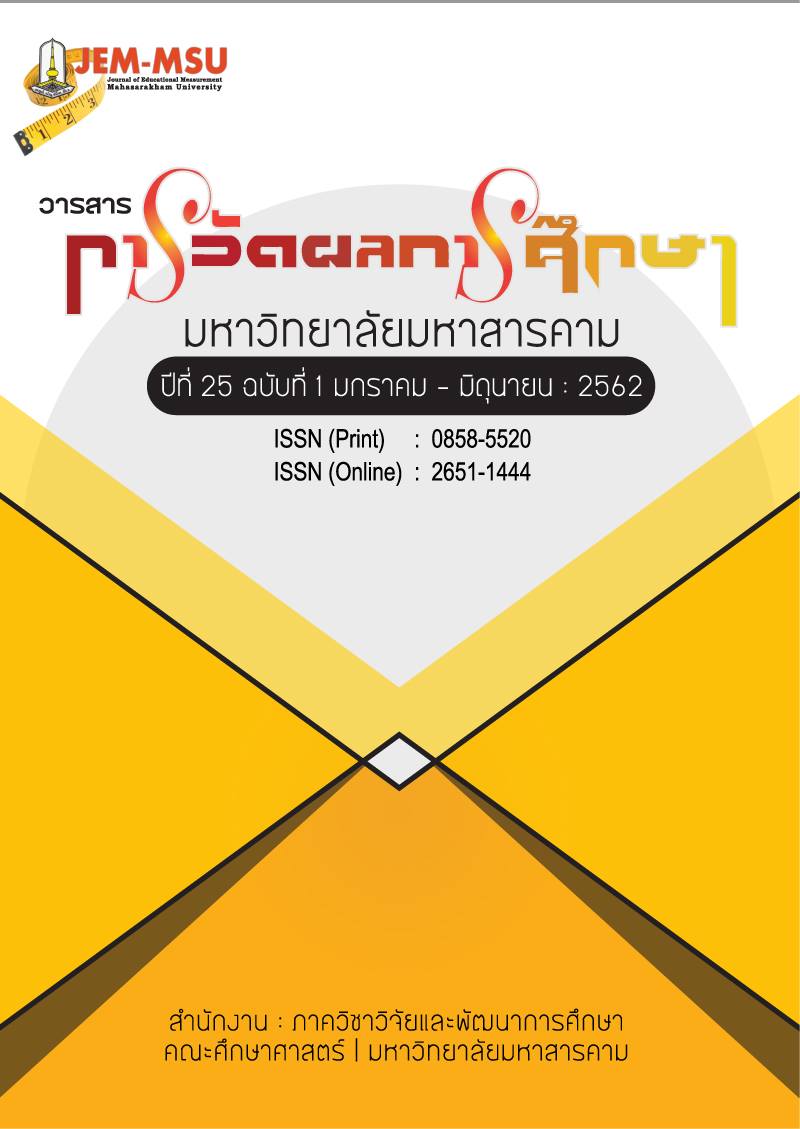A Discriminant Analysis of Factors Influencing Public Mind Of Lower Secondary School Students in Udon Thani Province
Main Article Content
Abstract
This study aimed to compare the variables affecting the public mind of lower secondary school students in Udon Thani Province, and to conduct a discriminant analysis of factors influencing the public mind of lower secondary school students, who had high or low public mind, in Udon Thani Province. The sample consisted of 383 lower secondary school students from 5 schools in Udon Thani Province in the academic year 2015, obtained through multi-stage random sampling. The research instruments used in the study consisted of a 5-point rating scale. It had 2 parts. The first part had a set of tests for the factors that influenced public mind on 6 aspects: the test on virtue and ethics, the test on emotional quotient, the test on parenting, the test on self-concept, the test on attitude toward public mind, and the test for future orientation. The test contained 48 items. The second part was the test on public mind, containing 30 items. The analysis of data employed a discriminant analysis. The results of the study are as follows:
1. The comparison of the difference of variables in the groups of students with different public mind, between the group with high public mind and the group with low public mind, with all of the 6 variables, revealed differences with statistical significance at the .01 level.
2. In the discriminant analysis of factors influencing the public mind of lower secondary school students, in the group with high public mind and the group with low public mind, 5 of 6 variables were chosen. Ranked in descending order according to the value of the correlation coefficients of discriminant analysis, the variables are as follows: virtue and ethics, the future orientation, attitude toward public mind, self-concept and emotional quotient. The discrimination had the accuracy at the .01 level of statistical significance. The group with high public mind had the accuracy of 89.0 percent while the group with low public mind had the accuracy of 88.0 percent, and both groups had the accuracy of 88.5 percent. The discriminant equations in raw and standard scores were as follows:
The discriminant raw scores
= -11.915 + .125 X1 + .087 X5 + .079 X6 + .057 X4 + .052X2
The discriminant standard scores
Y = .400 X1 + .355 X6 + .321 X5 + .231 X4 + .184 X2
In conclusion, the research findings suggested that the 5 variables could be used to discriminate students with high and low public mind. They could provide information for further development and promotion of students’ public mind.
Article Details
The content and information contained in the published article in the Journal of Educational Measurement Mahasarakham University represent the opinions and responsibilities of the authors directly. The editorial board of the journal is not necessarily in agreement with or responsible for any of the content.
The articles, data, content, images, etc. that have been published in the Journal of Educational Measurement Mahasarakham University are copyrighted by the journal. If any individual or organization wishes to reproduce or perform any actions involving the entirety or any part of the content, they must obtain written permission from the Journal of Educational Measurement Mahasarakham University.
References
กรมสุขภาพจิต. (2546). คู่มือพัฒนาทักษะการดำเนินชีวิตระดับประถมศึกษา. กรุงเทพฯ : โรงพิมพ์การศาสนา.
กระทรวงศึกษาธิการ. (2552). หลักสูตรแกนกลางการศึกษาขั้นพื้นฐาน พุทธศักราช 2551. กรุงเทพฯ: โรงพิมพ์ ชุมนุมสหกรณ์การเกษตรแห่งประเทศไทย จำกัด.
_________. (2556). นโยบายสำนักงานคณะกรรมการการศึกษาขั้นพื้นฐาน ปีงบประมาณ 2557. พิมพ์ครั้งที่ 1. กรุงเทพฯ : กลุ่มวิจัยและพัฒนานโยบาย สำนักงานคณะกรรมการการศึกษาขั้นพื้นฐานกระทรวงศึกษาธิการ.
เกรียงศักดิ์ เจริญวงศ์ศักดิ์. (2556). แนวทางการสร้างจิตสาธารณะในสังคมไทย. วารสารรัฐสภาสาร, 61(1), 77-78.
โกศล มีความดี. (2547). ปัจจัยทางจิตสังคมที่เกี่ยวข้องกับการมีจิตสาธารณะของขาราชการตำรวจ. ปริญญานิพนธ์วิทยาศาสตรมหาบัณฑิตสาขาการวิจัยพฤติกรรมศาสตร์ ประยุกต์กรุงเทพมหานคร บัณฑิตวิทยาลัย มหาวิทยาลัยศรีครินทรวิโรฒ.
ขณิดา นันทะวัน. (2554). ปัจจัยที่ส่งผลต่อจิตสาธารณะของนักศึกษาระดับปริญญาตรี คณะครุศาสตร์. การศึกษาค้นคว้าด้วยตนเอง การศึกษามหาบัณฑิต มหาวิทยาลัยนเรศวร.
ชัยวัฒน์ สุทธิรัตน์. (2553). สอนเด็กให้มีจิตสาธารณะ. กรุงเทพฯ : วีพริ้นท์.
ดวงเดือน พันธุมาวิน. (2524). พฤติกรรมศาสตร์ เล่ม 2 จิตวิทยาจริยธรรมและจิตวิทยาจริยธรรม. กรุงเทพฯ: ไทยวัฒนาพานิช.
ทรงศักดิ์ ภูสีอ่อน. (2556). การประยุกต์ใช้ SPSS วิเคราะห์ข้อมูลงานวิจัย. พิมพ์ครั้งที่ 6. มหาสารคาม: ตักสิลาการพิมพ์.
ทศพร ประเสริฐสุข. (2543). ความเฉลียวฉลาดทางอารมณ์กับการศึกษา. การแนะแนวและจิตวิทยา การศึกษา, 2(3-4), 18-19.
พรสุดา ศรีปัญญา. (2554). ปัจจัยเชิงสาเหตุที่มีอิทธิพลต่อจิตสาธารณะของนักเรียนชั้นมัธยมศึกษาปีที่ 6 จังหวัดร้อยเอ็ด การวิเคราะห์พหุระดับ. วิทยานิพนธ์หารศึกษามหาบัณฑิต มหาวิทยาลัยมหาสารคาม.
วิทยพัฒนท สีหา. (2551). ปัจจัยที่สัมพันธ์กับจิตสาธารณะของนิสิตระดับปริญญาตรี มหาวิทยาลัยมหาสารคาม. วิทยานิพนธ์การศึกษามหาบัณฑิต มหาวิทยาลัยมหาสารคาม.
สำนักงานคณะกรรมการพัฒนาการเศรษฐกิจและสังคมแห่งชาติ. (2558). รายงานประจำปี 2557 สำนักงานคณะกรรมการพัฒนาการเศรษฐกิจและสังคมแห่งชาติ. พิมพ์ครั้งที่ 1. กรุงเทพฯ: บริษัท ดอกเบี้ย จำกัด.
สื่อพลังงาน. (2542). จิตสำนึกสาธารณะ เส้นทางสู่ประชาสังคม. วารสารสื่อพลัง, 7(3), 3-19.
สุคนธ์ธา เส็งเจริญ. (2556). การวิเคราะห์โครงสร้างความสัมพันธ์เชิงสาเหตุของปัจจัยที่มี อิทธิพลต่อจิตสำนึกสาธารณะในนิสิตระดับปริญญาตรี มหาวิทยาลัยศรีนครินทรวิโรฒ .ปริญญานิพนธ์การศึกษามหาบัณฑิต บัณฑิตวิทยาลัย มหาวิทยาลัยศรีนครินทรวิโรฒ.
อัญชลิกา ผิวเพชร. (2554). ปัจจัยเชิงสาเหตุที่มีอิทธิพลต่อจิตสาธารณะของนักเรียนชั้นมัธยมศึกษาปีที่ 4 ในเขตภาคตะวันออกเฉียงเหนือตอนบน.วิทยานิพนธ์ กศ.ม. มหาสารคาม : มหาวิทยาลัยมหาสารคาม.
Seginer, Rachel.: & Hoda Halabi. (1991). Cross-Cultural Variations of Adolescents. Future Orientation: The Case of Israeli Druze versus Israeli Arab and Jewish Male. Journal of Cross Cultural Psychology, 22(2), 244-257.
Wright, D. (1975). The Psychology of Moral Behavior. Middle, England: Penguin Book.


